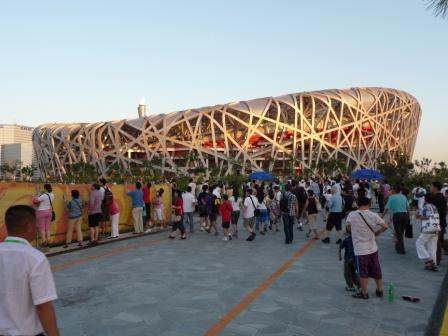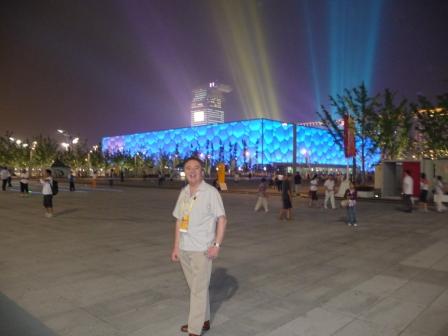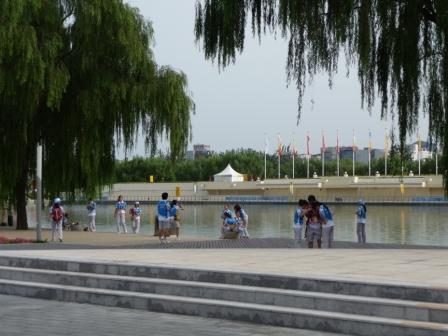August 28, 2008 | Posted by Shaun McCarthy
In the run-up to the Beijing Olympics, there was no shortage of criticism on the sustainability front – thousands of people were displaced to build the Olympic Park, while the smog, algae, choking traffic and alarming increase in demand for energy were all pointing to an environmental disaster. However, there is a positive sustainability story to be told here, and many lessons to be applied to London 2012. Beijing has a much publicised air-quality problem. The efforts to resolve this issue during the Olympics received some cynical press in the UK, but measures to manage air quality in the city have been in place for seven years with some success given the phenomenal increase in car use during that time. All cars are monitored for emissions and the decision to ban vehicles not complying with Euro 3 standards (Euro 4 after 2008) will be adopted permanently. The Beijing Metro is highly efficient and mercifully air-conditioned. The capacity of this system has risen from 1.57m passengers per day to over 3m during the Games. Ticket prices for the public transport system have been reduced for the Olympics, and free transport is provided to ticket and pass holders. The low prices will
…
August 22, 2008 | Posted by Shaun McCarthy
Tags: Beijing
London 2012 needs £2bn of private money to stage the games. LOCOG, the organisation charged with this responsibility, is a private company chaired by Lord Coe. The government owns the shares, but LOCOG is a separate organisation from the Olympic Delivery Authority, who are using public money to build the facilities that will be used for the games and beyond. Much of this money will come from corporate sponsorship partners. I have been spending some time with sponsors in Beijing to understand their potential contribution to a sustainable London 2012. I visited Coca-Cola and GE Eco-Imagination pavilions, and had a tour of McDonald’s outlets at the various venues. The pavilions are huge, two-storey buildings the size of several football pitches, housing exhibition areas open to the public, as well as VIP areas for corporate guests. The Chinese people are keen to soak up the whole experience and there are long queues outside many of the buildings. The Coke experience is particularly inspiring for the local people, as it celebrates the stunning recent achievements of China and honours its past by showcasing each province of China individually. Whilst there is a strong environmental section in the Coke pavilion, the GE Eco-Imagination
…
| Posted by Shaun McCarthy
We have all seen the pictures on the TV and in the papers but nothing could prepare me for the experience of the Bird’s Nest. The stadium is truly breathtaking and the emotional experience of being there to see the world’s elite sports people compete is like nothing I have ever witnessed. I was at Wembley to see my small town football club lift the FA cup in 1976 and I saw England lose to the Germans on penalties in the Euro 96 semi-final, I also saw the England rugby union team win back-to-back Grand Slams at Twickenham but these
…
August 21, 2008 | Posted by Shaun McCarthy
When I travelled all the way to China to learn about sustainability at an Olympic Games I did not expect to be writing about bottoms. There is a good environmental story to be told here, the Olympic Park and athletes’ village are zero emission zones with extensive use of electric and hydrogen powered vehicles. There are solar panels everywhere for both electricity and heating and the team here have created an 80 hectare conservation area to the north of the park which will be enjoyed by the public for generations to come. However, the most innovative approach is to be
…
August 20, 2008 | Posted by Shaun McCarthy
Healthy, quality and sustainable food is a big issue for London and the UK generally. The London Food Commission is active in this area and the ironically entitled Curry Report on Food from Sir Don Curry set out the national perspective. On the ground, organisations like the London Food Link and the Coriander Club are doing some great work. It is interesting to know what we can learn from Beijing. Beijing is a huge, cosmopolitan metropolis which 17 million people call “home”. The place has become an orgy of consumerism and food is no exception. You can get everything here from the ubiquitous Starbucks, McDonalds and Pizza Hut to top class restaurants serving Chinese regional dishes, western and other eastern cuisine. You can find street vendors selling little wooden kebabs with tasty treats from chicken to deep fried cockroach (I stuck to the chicken), there are restaurants selling stir fried bullfrog and snake skin but it seems the authorities have banned the sale of dog during the games for fear of offending western sensitivities (but cockroach is still OK). I even found an oriental kebab stall. The stallholders seem to be obliged to wear face masks, presumably to prevent them
…
August 19, 2008 | Posted by Shaun McCarthy
We have all heard the negative stories. Displacing thousands of people to build the Olympic Park in Beijing, the smog, the algae, the choking traffic and the alarming increase in demand for energy. However, there is a positive sustainability story to be told here and many lessons we can learn for London 2012. On the social side, the city has recruited 1.5 million volunteers to help with the games, from the blue shirted people who assist at the venues and other key locations, including transport locations, to the social volunteers who have been trained simply to help people when they
…
August 15, 2008 | Posted by Shaun McCarthy
Tags: Beijing
The experience of Beijing compared to London is one of similarities and contrasts. The sheer scale of growth in Beijing is incredible and the city is expanding in all directions in a grid system surrounded by a series of massive concentric ring roads whereas London is really a collection of small communities that have grown together over centuries. However they do share an environmental challenge with air quality. While the Beijing smog has captured the headlines and made for some dramatic photo opportunities, London is not as immune to the ills of air pollution as we might like to think. Although the UK’s air quality problems are less visible to the naked eye, or indeed the camera, they are still very much an issue. Once the Beijing Games are over, and all eyes turn towards London, we will have to prove that our clear skies are not harbouring an invisible threat. London is widely recognised as one of the most polluted cities in Europe for tiny particulates. These exacerbate conditions such as asthma and lung disease, with poor air quality resulting in between 12,000 and 24,000 premature deaths each year in the UK. As well as this human cost, there
…
August 12, 2008 | Posted by Shaun McCarthy
It seems ironic that my first experience of an Olympic Games starts with my first experience of Heathrow Terminal 5. I worked for BAA for 11 years, joining in 1995, the week the T5 enquiry started. This turned out to be the longest public enquiry in English legal history, nearly 7 years, eclipsing the enquiry for Sizewell B nuclear power station. I was involved in various elements of T5 up until I decided to leave in 2006 to pursue a more independent career but up to now I have never experienced T5 as a customer. The environmental achievements of T5, using 70% non-potable water, use of waste CHP heat from an existing facility, high standards for construction and schemes for local employment were best practice at the time. We expect these to be matched or surpassed by the ODA and there are encouraging signs that this will be achieved. However, T5 was not all success, the building is nowhere near as energy efficient as it could be and early ambitions to eliminate materials such as non-sustainable timber, HFC and PVC were not wholly successful. An independent environmental advisory group (EAG) was set up to challenge and recommend targets for T5.
…


